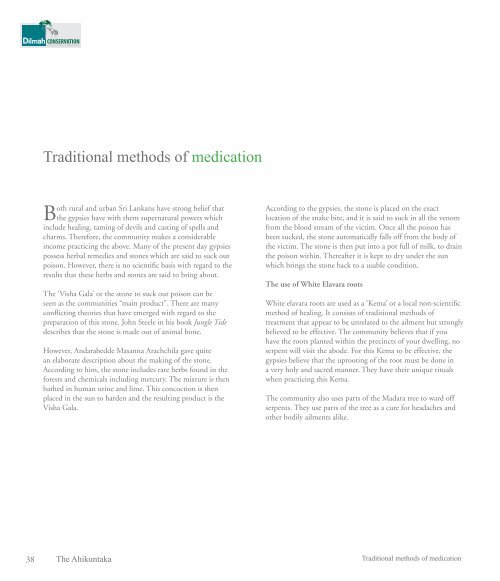The Ahikuntaka
A publication documenting the lives and livelihoods of the Ahikuntaka or gypsy community in Sri Lanka. A collection of vibrant photographs and a baseline survey on the current socio economic status of the Ahikuntaka conducted by the Colombo University complement this timely publication.
A publication documenting the lives and livelihoods of the Ahikuntaka or gypsy community in Sri Lanka. A collection of vibrant photographs and a baseline survey on the current socio economic status of the Ahikuntaka conducted by the Colombo University complement this timely publication.
You also want an ePaper? Increase the reach of your titles
YUMPU automatically turns print PDFs into web optimized ePapers that Google loves.
www.dilmahconservation.org<br />
Traditional methods of medication<br />
Both rural and urban Sri Lankans have strong belief that<br />
the gypsies have with them supernatural powers which<br />
include healing, taming of devils and casting of spells and<br />
charms. <strong>The</strong>refore, the community makes a considerable<br />
income practicing the above. Many of the present day gypsies<br />
possess herbal remedies and stones which are said to suck out<br />
poison. However, there is no scientific basis with regard to the<br />
results that these herbs and stones are said to bring about.<br />
<strong>The</strong> ‘Visha Gala’ or the stone to suck out poison can be<br />
seen as the communities “main product”. <strong>The</strong>re are many<br />
conflicting theories that have emerged with regard to the<br />
preparation of this stone. John Steele in his book Jungle Tide<br />
describes that the stone is made out of animal bone.<br />
However, Andarabedde Masanna Arachchila gave quite<br />
an elaborate description about the making of the stone.<br />
According to him, the stone includes rare herbs found in the<br />
forests and chemicals including mercury. <strong>The</strong> mixture is then<br />
bathed in human urine and lime. This concoction is then<br />
placed in the sun to harden and the resulting product is the<br />
Visha Gala.<br />
According to the gypsies, the stone is placed on the exact<br />
location of the snake bite, and it is said to suck in all the venom<br />
from the blood stream of the victim. Once all the poison has<br />
been sucked, the stone automatically falls off from the body of<br />
the victim. <strong>The</strong> stone is then put into a pot full of milk, to drain<br />
the poison within. <strong>The</strong>reafter it is kept to dry under the sun<br />
which brings the stone back to a usable condition.<br />
<strong>The</strong> use of White Elavara roots<br />
White elavara roots are used as a ‘Kema’ or a local non-scientific<br />
method of healing. It consists of traditional methods of<br />
treatment that appear to be unrelated to the ailment but strongly<br />
believed to be effective. <strong>The</strong> community believes that if you<br />
have the roots planted within the precincts of your dwelling, no<br />
serpent will visit the abode. For this Kema to be effective, the<br />
gypsies believe that the uprooting of the root must be done in<br />
a very holy and sacred manner. <strong>The</strong>y have their unique rituals<br />
when practicing this Kema.<br />
<strong>The</strong> community also uses parts of the Madara tree to ward off<br />
serpents. <strong>The</strong>y use parts of the tree as a cure for headaches and<br />
other bodily ailments alike.<br />
38 <strong>The</strong> <strong>Ahikuntaka</strong><br />
Traditional methods of medication















